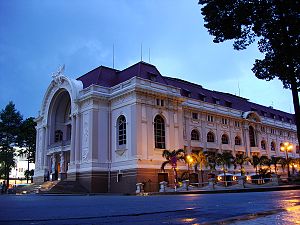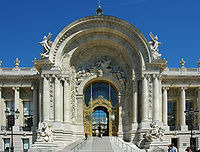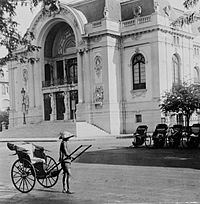- Municipal Theatre, Ho Chi Minh City
-
Coordinates: 10°46′35.39″N 106°42′11.23″E / 10.7764972°N 106.7031194°E
The Saigon Opera House (Vietnamese: Nhà hát lớn Thành phố Hồ Chí Minh), an opera house in Ho Chi Minh City, Vietnam, is an example of French Colonial architecture in Vietnam.
Built in 1897 by French architect Ferret Eugene, the 800 seat building was used as the home of the Lower House assembly of South Vietnam after 1956. It was not until 1975 that it was again used as a theatre, and restored in 1995.
Contents
Architecture
Saigon Opera House is a smaller counterpart of the Hanoi Opera House (built from 1901 to 1911, and shaped like the Opéra Garnier in Paris). The Saigon Opera House owes its specific characteristics to the work of architect Félix Olivier, while construction was under supervision of architects Ernest Guichard and Eugène Ferret in 1900.
Its architectural style is influenced by the flamboyant style of the French Third Republic with the façade shaped like the Petit Palais which was built in the same year in France. The house had a main seating floor plus two levels of seating above, and was capable of accommodating 1,800 people. The design of all the inscriptions, décor, and furnishings were drawn by a French artist and sent from France.
However, the décor of the façade faced some criticisms. In accordance with Gothic style, the house facade was decorated with inscription and reliefs (like City Hall), but it was criticized as being too complicated. In 1943, some of the complicated decoration was removed. On the occasion of 300th anniversary of Saigon in 1998, the city government had some façade decor restored.
History
After the complete invasion of Cochinchina, in 1863 the French colonists invited a theatre company to Saigon to perform for the French legion in the villa of the French admiral at the Clock Square (Place de l'Horloge) (today, this is the corner of Nguyen Du and Dong Khoi streets). After a short time, a temporary theatre was built at the site of what is now the Caravelle Hotel. In 1898, the construction of the new theatre commenced on the site of the old one, and it was completed by 1 January 1900.
Between World War I and World War II, all costs of mobilization and demobilization as well as other costs for the theatre companies from France to Saigon were paid by the municipal government. Despite the fact that the theatre was planned as an entertainment venue for the growing middle class, its audience declined as more and more night clubs and dance halls boomed in the city. During this period, performances were presented only occasionally, some being concerts and others cai luong programs.
Following from the criticisms of the theatre’s façade and the high costs of organizing performances, the municipal government intended to turn the theatre into a concert hall (Salle de Concert), but this was never carried out. Instead, the theatre façade's decorations, engravings and statues were removed in 1943 to make the theatre look more youthful. In 1944, the theatre was damaged by the Allied aerial attacks against Japanese Imperial Army and the theatre stopped functioning. As Japan surrendered to the Allied forces, France returned to Cochichina. In 1954, the French army surrendered to Viet Minh during the Battle of Dien Bien Phu which led to the Geneva Accords in the same year. The theatre was then used as a temporary shelter for French civilians immigrating from North Vietnam.
In 1955, the theatre was restored for the purpose of becoming the seat of the Lower House of the State of Vietnam, then the Republic of Vietnam. After the Fall of Saigon in 1975, the building was restored to its original function as a theatre. In 1998, on the occasion of 300th anniversary of the founding of Saigon, the municipal government had the theatre façade restored.
References
External links
Categories:- Buildings and structures in Ho Chi Minh City
- Opera houses in Vietnam
- Visitor attractions in Ho Chi Minh City
- French Colonial architecture in Vietnam
Wikimedia Foundation. 2010.



